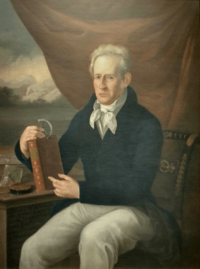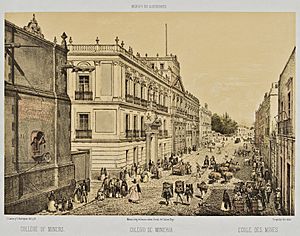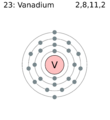Andrés Manuel del Río facts for kids
Quick facts for kids
Andrés Manuel del Río
|
|
|---|---|

Andrés Manuel del Río
|
|
| Born | 10 November 1764 |
| Died | 23 March 1849 (aged 84) |
| Nationality | Spanish, later nationalized Mexican |
| Alma mater | University of Alcalá de Henares |
| Known for | vanadium |
| Scientific career | |
| Fields | natural history chemistry |
| Influences | Abraham Gottlob Werner, Jean Darcet, Antoine Lavoisier, René Just Haüy |
Andrés Manuel del Río y Fernández (born November 10, 1764 – died March 23, 1849) was a Spanish scientist and engineer. He became a Mexican citizen later in life. In 1801, he discovered compounds of a new element, which we now call vanadium. He suggested names like panchromium or erythronium for it. However, his discovery wasn't recognized at the time.
Contents
A Young Scientist's Journey
Andrés del Río was born in Madrid, Spain. He studied analytical chemistry and metallurgy there. At just 15 years old, he earned his bachelor's degree. This was from the University of Alcalá de Henares in 1780.
The Spanish government gave him a special scholarship. This allowed him to study at the Royal Academy of Mines in Almadén. He was very talented and received another grant in 1783. This grant helped him study in Paris, France. There, he learned from the famous chemist Jean Darcet.
Del Río continued his studies in Germany. He went to the Mining Academy in Freiberg. He met Baron Alexander von Humboldt there. He also studied in Hungary and England. In 1791, he returned to Paris. He worked with Antoine Lavoisier, who is known as the father of modern chemistry. He also worked with Abbé René Just Haüy, a founder of crystallography.
Sadly, Lavoisier was arrested during the French Revolution. Del Río had to escape to England for his safety.
Teaching and Discoveries in Mexico
In 1792, a new school was founded in New Spain (which is now Mexico). It was called the Real Seminario de Minería, or College of Mines. Its goal was to improve mining and metallurgy studies. Fausto Elhúyar, who discovered tungsten, was the first head of the college.
In 1793, Elhúyar offered Del Río a teaching job. Del Río accepted the position for mineralogy. He arrived in Veracruz, Mexico, in October 1794. He quickly started teaching and doing scientific research. On April 27, 1795, he taught the first mineralogy course in New Spain.
Del Río made important studies of minerals. He also created new mining methods. He wrote the first mineralogy textbook published in America. It was called Elementos de Orictognosía. The first part came out in 1795, and the second in 1805. His student, Santiago Ramírez, called it "a monumental work."
The famous German naturalist, Alexander von Humboldt, visited Mexico. He praised Del Río's textbook. Humboldt spent a year in Mexico City. He renewed his friendship with Del Río. They explored areas like Chapultepec and collected mineral samples.
In 1820, Del Río became a deputy to the Spanish government. He supported Mexico's independence. Even though he was invited to stay in Spain, he returned to Mexico in 1821. He considered Mexico his home.
In 1829, after Mexico became independent, the government expelled most Spaniards. Del Río was one of the few allowed to stay. However, he was upset about his colleagues being forced to leave. So, he chose to go into exile in Philadelphia, USA, for four years.
In Philadelphia, he was highly respected. He joined the American Philosophical Society. He also became president of the Geological Society of Philadelphia. A new edition of his book was published there in 1832. Del Río returned to Mexico in 1834. He continued teaching mineralogy and geology at the college.
The Discovery of Vanadium
In 1801, Del Río was studying mineral samples. These samples came from a mine in Zimapán, Mexico. He realized he had found a new metallic element. He made different compounds of this element. They showed many different colors. So, he named the element panchromium, meaning "all colors." Later, he saw that the compounds turned red when heated. He then changed the name to erythronium, meaning "red."
The next year, he gave samples to Alexander von Humboldt. Humboldt sent them to Hippolyte Victor Collet-Descotils in Paris for testing. Collet-Descotils wrongly said the samples only had chromium. Because of this, Humboldt doubted Del Río's discovery. Del Río himself thought he had made a mistake.
In 1830, almost 30 years later, Professor Nils Gabriel Sefström in Sweden rediscovered the element. He found it in an iron sample. He named it vanadium. This name honored Vanadis, the Scandinavian goddess of love and beauty.
That same year, the German chemist Friedrich Wöhler proved something important. He analyzed some of Del Río's original samples. He showed that Sefström's vanadium and Del Río's erythronium were the same element!
In 1831, an American geologist, George William Featherstonhaugh, suggested a new name. He wanted to call the element rionium to honor Del Río. But this name was not chosen.
In 1867, the English chemist Henry Enfield Roscoe finally isolated the pure metal. He was the first to do so.
Later Life and Legacy
In 1805, Del Río started an ironworks in Coalcomán, Mexico. He faced many challenges. But on April 29, 1807, he produced the first iron in Mexico. His iron was even better than the famous imported iron from Spain. However, during the Mexican War of Independence, royalist forces destroyed his ironworks.
Del Río was disappointed that Humboldt had not confirmed his discovery of vanadium. He continued to teach at the College of Mines until he died. His teaching was considered very advanced for its time.
Death and Recognition
Andrés Manuel del Río passed away in 1849 at 84 years old. He had a long and important career. His work and his support for independence helped build the new Mexican nation. He was the first professor of mineralogy at the College of Mines. This college later became part of the National Autonomous University of Mexico (UNAM).
He was a member of many important scientific groups around the world. These included the Spanish Royal Academy of Sciences and the American Philosophical Society. He was also president of the Geological Society of Philadelphia.
Besides discovering vanadium, he found and described other minerals. He also invented new ways to extract minerals for mining. After he died, a major mining area in Chihuahua was named in his honor.
The Chemical Society of Mexico created a special award in 1964. It is called the National Chemistry Prize "Andrés Manuel Del Río." This prize honors chemists who have made great contributions. It comes with a medal showing Del Río's face.
Selected Scientific Works
- Elementos de Orictognesia o del conocimiento de los fósiles, 1795. This was his important textbook.
- Analyse des deux nouvelles espéces minérales composées de séléniure de zinc et de sulfure de mercure. Annales des Mines, Paris, 5, 1829.
- Découverte de l'iodure de mercure au Mexique. Annales des Mines, Paris, 5, 1829.
- Elementos de Orictognesia, o del conocimiento de los fósiles según el sistema de Bercelio; y según los principios de Abraham Góttlob Wérner, con la sinonimia inglesa, alemana y francesa, para uso del Seminario Nacional de Minería de México. Philadelphia, 1832, ISBN: 9780270612905.
Images for kids
See also
 In Spanish: Andrés Manuel del Río para niños
In Spanish: Andrés Manuel del Río para niños










